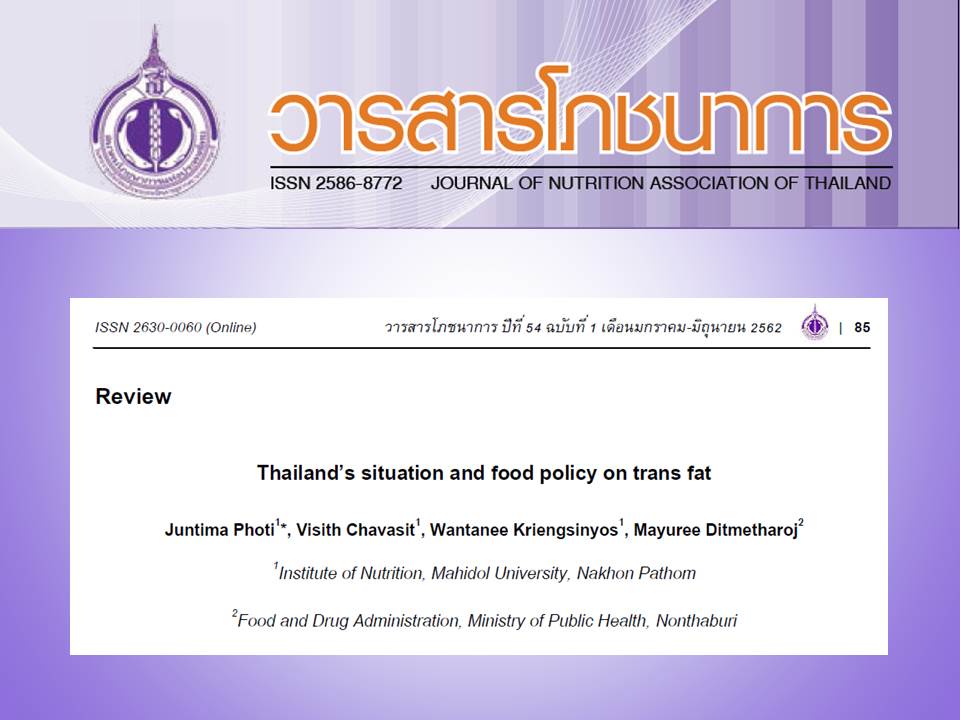Thailand’s Situation and Food Policy on Trans Fat
Keywords:
กรดไขมันทรานส์, น้ำมันที่ผ่านการเติมไฮโดรเจนบางส่วน, เบเกอรีAbstract
Partially hydrogenated oil (PHO) is the primary source of trans fatty acid that is also found in natural from remnant animal products like cattle’s milk, beef and butter. Trans fatty acid consumed from foods may increase the potential risk of cardiovascular disease by causing the evaluated low-density lipoprotein (LDL) and decreased high-density lipoprotein (HDL) levels. Current studies on trans fatty acid in selected food groups indicate that the majority of fat-related health problems in Thailand may be the result of saturated fatty acid consumption instead of trans fatty acid. Only some samples from the commercial markets of butter, shortening, margarine, fried donuts, puffs and pastries contained trans fatty acid at the level over the FAO/WHO recommendation (> 0.5 g/serving). However, oil blending technique is developed for PHO replacements by mixing at least two kinds of oil containing different degrees of saturation until the desirable physical properties are achieved. Furthermore, a Ministry of Public Health notification is issued to prohibit producing, importing, or selling PHO and any food made from PHO in Thailand which will be in effect from December 10, 2018.
References
2. Talbot G. Specialty oils and fats in food and nutrition: properties, processing and applications. Cambridge: Wood head Publishing; 2015.
3. Gupta M. Practical guide to vegetable oil processing. Urbana: AOCS press; 2017.
4. Lai OM, Tan CP, Akoh CC, editor. Palm oil: production, processing, characterization, and uses. Urbana: AOCS press; 2012.
5. Dijkstra AJ, Hamilton RJ, Hamm W. Trans fatty acids. Iowa: Blackwell; 2008.
6. Alfaia C, Alves S, Martins S, Costa A, Fontes C, Lemos J, et al. Effect of feeding system on intramuscular fatty acids and conjugated linoleic acid isomers of beef cattle, with emphasis on their nutritional value and discriminatory ability. Food Chem. 2009;114:939-946.
7. Kuhnt K, Baehr M, Rohrer C, Jahreis G. Trans fatty acid isomers and the trans-9/trans-11 index in fat containing foods. Eur J Lipid Sci Technol. 2011;113(10):1281–1292.
8. WHO. Replace trans fat: Frequently asked question [document on the internet]. Geneva: WHO; 2018 [updated 2018 May; cited 2018 Sep 25]. Available from: https://www.who.int/docs /default-source/documents/replace-trans fats/replace-trans-fat-faqs.pdf?Status= Temp&sfvrsn=956d171 f_6
9. วิสิฐ จะวะสิต, วันทนีย์ เกรียงสินยศ, จันทิมา โพธิ, ทิพย์วรรณ ปริญญาศิริ, มยุรี ดิษย์เมธาโรจน์. โครงการประเทศไทยปล อดไขมันทรานส์. รายงานการวิจัยการ เกษตร (ฉบับสมบูรณ์).กรุงเทพมหานคร: สำนักงานพัฒนาการวิจัยการเกษตร; 2561.
10. Przybylski O, Aladedunye FA. Forma tion of trans fats during food prepara tion. Can J Diet Pract Res. 2012;73 (2):98-101.
11. Bhardwaj S, Passi SJ, Misra A, Pant KK, Anwar K, Pandey RM, et al. Effect of heating/reheating of fats/oils, as used by Asian Indians, on trans fatty acid formation. Food Chem. 2016; 212:663-670.
12. Chen , Yang Y, Nie S, Yang X, Wang Y, Yang M, Chang Li, et al. The analysis of trans fatty acid profiles in deep frying palm oil and chicken fillets with an improved gas chromatography method. Food Control. 2014;4:191-197.
13. WHO. Diet, Nutrition and the Prevention of Chronic Diseases. Report of a Joint WHO/FAO Expert Consulta tion. WHO Technical Report Series 916. Geneva: WHO; 2003.
14. Dhaka V, Gulia N, Ahlawat KS, Khatkar SB. Trans fats—sources, health risks and alternative approach - A review. J Food Sci Technol. 2011;48(5):534–541.
15. Mozaffarian D, Katan MB, Ascherio A, Stampfer MJ, Willett WC. Trans fatty acids and cardiovascular disease. N Engl J Med. 2006;354:1601-1613.
16. Mozaffarian D, Aro A, Willett WC. Health effects of trans-fatty acids: experimental and observational evid ence. Eur J Clin Nutr. 2009;63 (S2):S5-21.
17. วิสิฐ จะวะสิต, สมเกียรติ โกศัลวัฒน์, ธีรชัย ว่องเมทินี, ศศิอำไพ พฤฒิพรธานี, ดารณี หมู่ขจรพันธ์, ทิพย์วรรณ ปริญญาศิริ และคณะ. การสำรวจสถานการณ์การปนเปื้อนของกรดไขมันชนิดทรานส์ในผลิตภัณฑ์อาหารในประเทศไทย. มูลนิธิสาธารณสุขแห่งชาติ และสำนักงานกองทุนสนับสนุนการวิจัย; 2550.
18. นันทยา จงใจเทศ, ภัทธิรา ยิ่งเลิศรัตนะกุล, ปิยนันท์ เผ่าม่วง, วารีทิพย์ พึ่งพันธ์. ปริมาณไขมันทรานส์ในอาหารอบและทอด. รายงานการศึกษาวิจัย. นนทบุรี: กองโภชนาการ กรมอนามัย กระทรวงสาธารณสุข; 2550.
19. กมลกาญจน์ จิญกาญจน์, บังอร บุญชู, วิภาวรรณ ศรีมุข.การสำรวจเบื้องต้น: ปริมาณไขมันทรานส์ในอาหารทอด ขนมอบ ไขมันและนํ้ามันสำหรับบริโภค นมและผลิตภัณฑ์นม. Bulletin of Applied Sciences. 2014;3(3):81-87.
20. รัฐธรรมนูธแห่งราชอาณาจักรไทย พ.ศ. 2541. ราชกิจจานุเบกษา เล่ม 115 ตอน 47 ง, 11 มิถุนายน 2541.
21. USFDA. Trans Fat [document on the internet]. Maryland: USFDA; 2018 [updated 2018 May 18; cited 2018 Sep 25]. Available from: https://www.fda.gov /food/ucm292278.htm
22. รัฐธรรมนูธแห่งราชอาณาจักรไทย พ.ศ. 2561. ราชกิจจานุเบกษา เล่ม 135 ตอนพิเศษ 166 ง, 13 กรกฏาคม 2561.
23. Codex Alimentarius Commission. Discussion paper on claim for “free” of trans fatty acids [document on the internet]. Berlin: Codex Alimentarius Commission; 2017 [cited 2018 Sep 25].Available from: https://www.fao.org /fao-who-codexalimentarius/sh-proxy/es /?lnk =1&url=https%253A%252F%252 Fwork space.fao.org%252Fsites%252F codex%252FMeetings%252FCX-720-39 %252Fnf 39_09e.pdf.
24. USFDA. Guidance for industry: Trans fatty acids in nutrition labeling, nutrient content claims, health Claims; small entity compliance guide [document on the internet]. Maryland: USFDA; 2003 [updated 2018 Sep 20; cited 2018 Sep 25]. Available from: https://www.fda.gov /Food/ GuidanceRegulation/Guidance DocumentsRegulatoryInformation/ucm053479.htm
25. Canadian Food Inspection Agency. Specific nutrient content claim requirements: Trans fatty acid claims [document on the internet]. Ontario: Canadian Food Inspection Agency; 2016 [updated 2018 May 11; cited 2018 Sep 25]. Available from: https://www.inspection.gc.ca/food/ label ling/food-labelling-for-industry/nutrient-content/specific-claim-requirements/eng /13899077 70176/1389907817577? chap=6

Downloads
Published
How to Cite
Issue
Section
License
Upon acceptance of an article, copyright is belonging to the Nutrition Association of Thailand.


